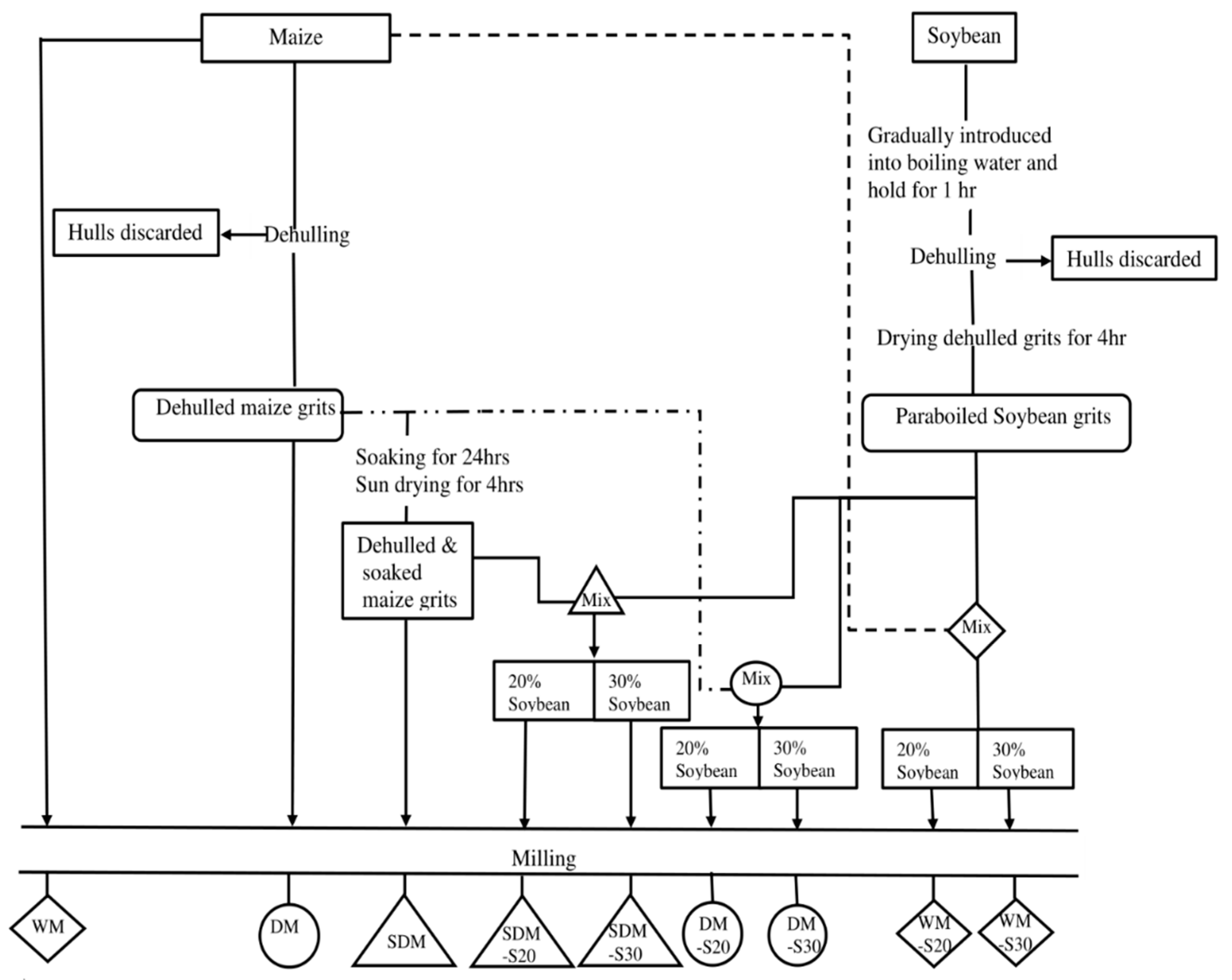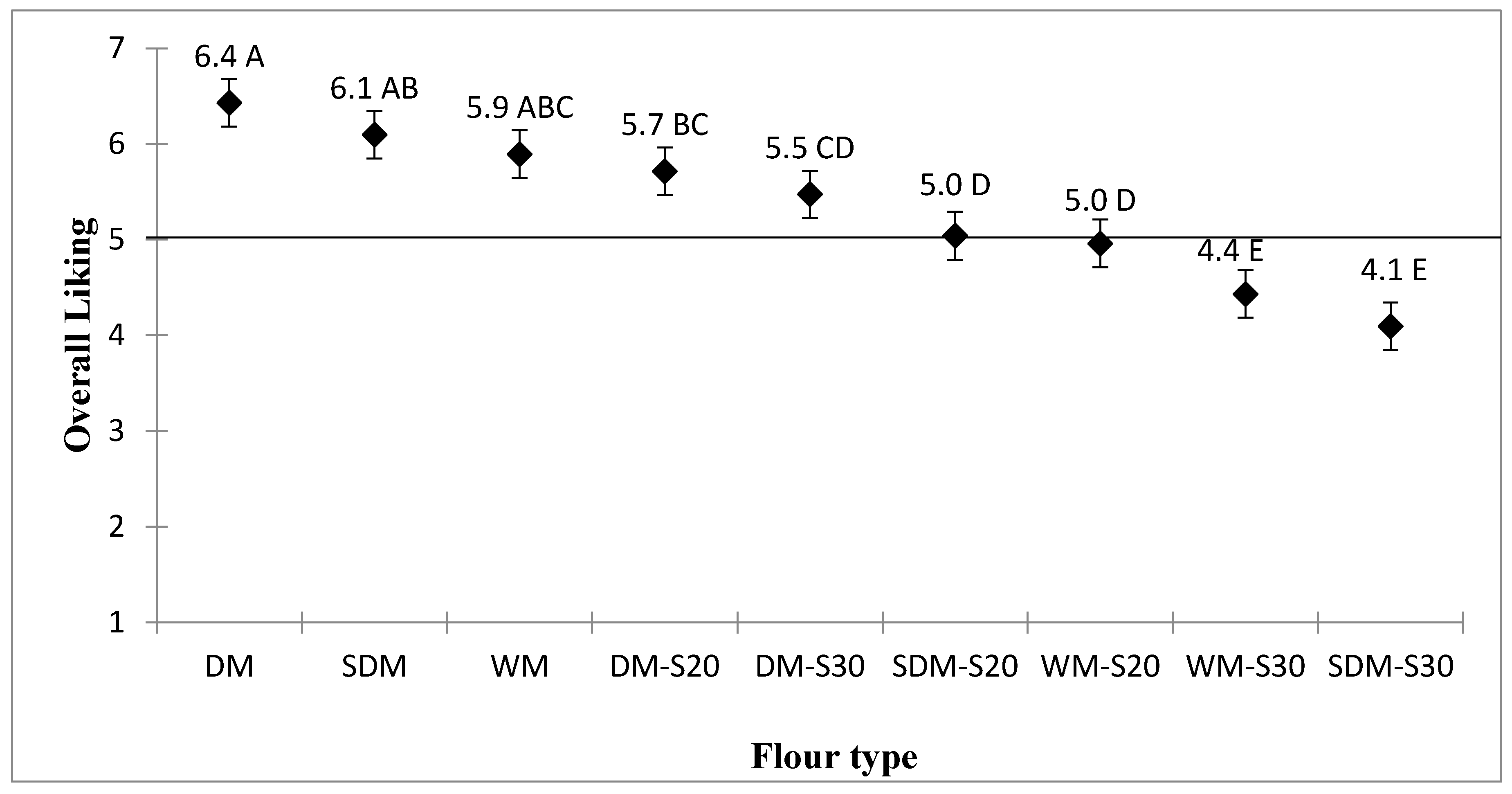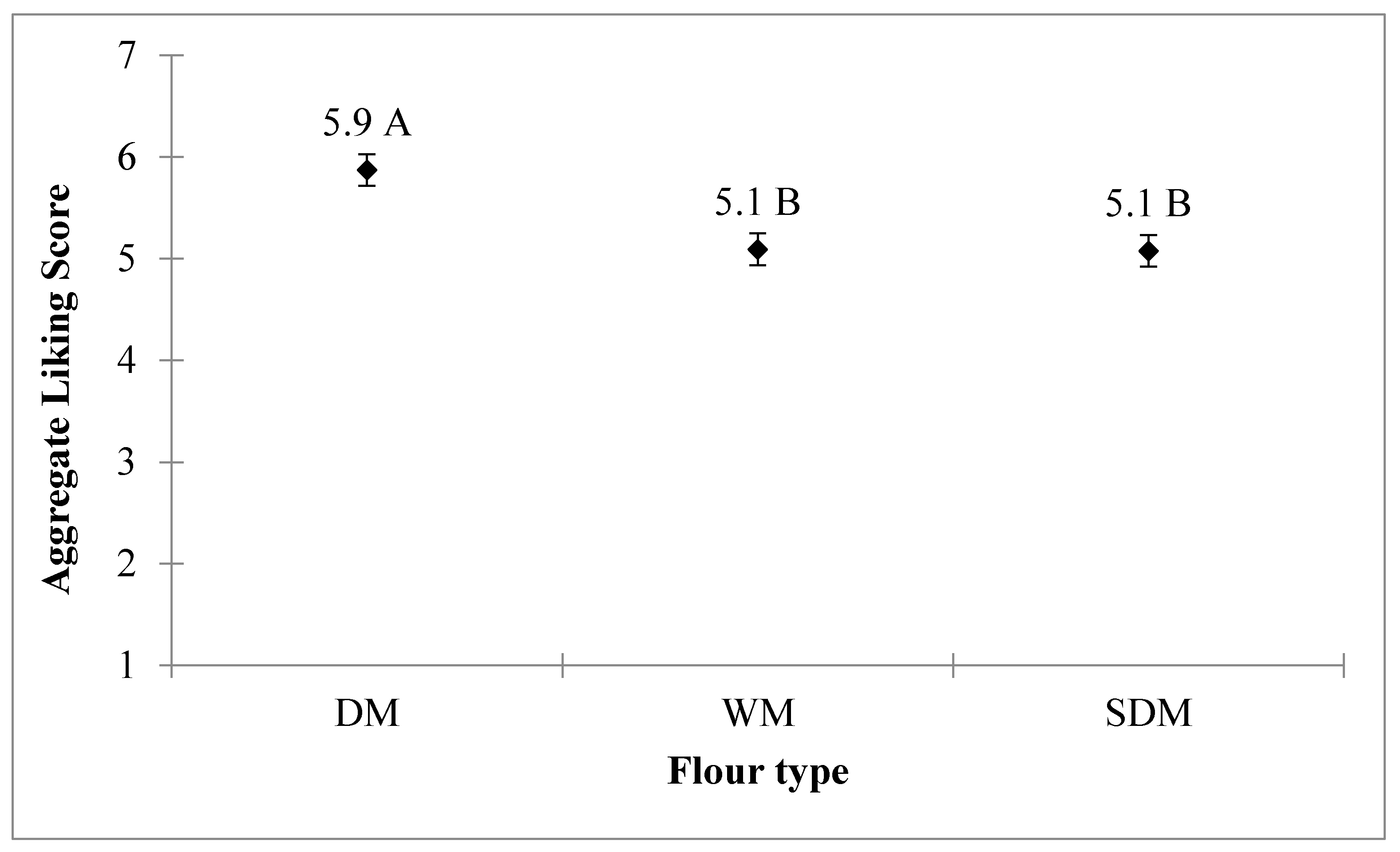Hydrothermally Treated Soybeans Can Enrich Maize Stiff Porridge (Africa’s Main Staple) without Negating Sensory Acceptability
Abstract
:1. Introduction
2. Materials and Methods
2.1. Experimental Flours
2.2. Preparation of Maize Stiff Porridges and Warming
2.3. Consumer Acceptability
2.4. Data Analysis
3. Results
4. Discussion
5. Conclusions
Supplementary Materials
Author Contributions
Funding
Conflicts of Interest
Ethical approval
Data availability
References
- Schönfeldt, H.C.; Hall, N.G. Dietary protein quality and malnutrition in Africa. Br. J. Nutr. 2012, 108, S69–S76. [Google Scholar] [CrossRef] [PubMed] [Green Version]
- Akombi, B.J.; Agho, K.E.; Merom, D.; Renzaho, A.M.; Hall, J.J. Child malnutrition in sub-Saharan Africa: A meta-analysis of demographic and health surveys (2006-2016). PLoS ONE 2017, 12, e0177338. [Google Scholar] [CrossRef] [PubMed] [Green Version]
- Hetherington, J.B.; Wiethoelter, A.K.; Negin, J.; Mor, S.M. Livestock ownership, animal source foods and child nutritional outcomes in seven rural village clusters in Sub-Saharan Africa. Agric. Food Secur. 2017, 6, 9. [Google Scholar] [CrossRef] [Green Version]
- Uusiku, N.P.; Oelofse, A.; Duodu, K.G.; Bester, M.J.; Faber, M. Nutritional value of leafy vegetables of sub-Saharan Africa and their potential contribution to human health: A review. J. Food Compos. Anal. 2010, 23, 499–509. [Google Scholar] [CrossRef]
- Flax, V.L.; Phuka, J.; Cheung, Y.B.; Ashorn, U.; Maleta, K.; Ashorn, P. Feeding patterns and behaviors during home supplementation of underweight Malawian children with lipid-based nutrient supplements or corn-soy blend. Appetite 2010, 54, 504–511. [Google Scholar] [CrossRef] [PubMed]
- Mangani, C.; Maleta, K.; Phuka, J.; Cheung, Y.B.; Thakwalakwa, C.; Dewey, K.; Ashorn, P. Effect of complementary feeding with lipid-based nutrient supplements and corn–soy blend on the incidence of stunting and linear growth among 6- to 18-month-old infants and children in rural Malawi. Matern. Child Nutr. 2015, 11, 132–143. [Google Scholar] [CrossRef] [Green Version]
- De Groote, H.; Kimenju, S.C. Consumer preferences for maize products in urban Kenya. Food Nutr. Bull 2012, 33, 99–110. [Google Scholar] [CrossRef]
- Khumalo, T.P.; Schönfeldt, H.C.; Vermeulen, H. Consumer acceptability and perceptions of maize meal in Giyani, South Africa. Dev. S. Afr. 2011, 28, 271–281. [Google Scholar] [CrossRef]
- Pillay, K.; Derera, J.; Siwela, M.; Veldman, F.J. Consumer acceptance of yellow, provitamin A-biofortified maize in KwaZulu-Natal. S. Afr. J. Clin. Nutr. 2011, 24, 186–191. [Google Scholar] [CrossRef]
- Stevens, R.; Winter-Nelson, A. Consumer acceptance of provitamin A-biofortified maize in Maputo, Mozambique. Food Policy 2008, 33, 341–351. [Google Scholar] [CrossRef]
- Chedea, V.S.; VICAS, S.; Socaciu, C. Kinetics of soybean lipoxygenases are related to pH, substrate availability and extraction procedures. J. Food Biochem. 2008, 32, 153–172. [Google Scholar] [CrossRef]
- Zhang, Y.; Guo, S.; Liu, Z.; Chang, S.K. Off-flavor related volatiles in soymilk as affected by soybean variety, grinding, and heat-processing methods. J. Agric. Food Chem. 2012, 60, 7457–7462. [Google Scholar] [CrossRef]
- Lv, Y.C.; Song, H.L.; Li, X.; Wu, L.; Guo, S.T. Influence of Blanching and Grinding Process with Hot Water on Beany and Non-Beany Flavor in Soymilk. J. Food Sci. 2011, 76, S20–S25. [Google Scholar] [CrossRef]
- Sun, C.X.; Cadwallader, K.R.; Kim, H. Comparison of key aroma components between soymilks prepared by cold and hot grinding methods. In Chemistry, Texture and Flavor of Soy; Cadwallader, K., Chang, S.K.C., Eds.; ACS Symposium Series 1059; American Chemical Society: Washington, DC, USA, 2010; pp. 361–373. [Google Scholar]
- Nishinari, K.; Fang, Y.; Guo, S.; Phillips, G.O. Soy proteins: A review on composition, aggregation and emulsification. Food Hydrocoll. 2014, 39, 301–318. [Google Scholar] [CrossRef]
- Nuss, E.T.; Tanumihardjo, S.A. Maize: A paramount staple crop in the context of global nutrition. Compr. Rev. Food Sci. Food Saf. 2010, 9, 417–436. [Google Scholar] [CrossRef]
- Bowers, J.A.; Saadat, M.A.; Whitten, C. Effect of liking, information and consumer characteristics on purchase intention and willingness to pay more for a fat spread with a proven health benefit. Food Qual. Prefer. 2003, 14, 65–74. [Google Scholar] [CrossRef]
- Cho, H.Y.; Chung, S.J.; Kim, H.S.; Kim, K.O. Effect of sensory characteristics and non-sensory factors on consumer liking of various canned tea products. J. Food Sci. 2005, 70, s532–s538. [Google Scholar] [CrossRef]
- Steenhuis, I.H.; Waterlander, W.E.; De Mul, A. Consumer food choices: The role of price and pricing strategies. Public Health Nutr. 2011, 14, 2220–2226. [Google Scholar] [CrossRef] [Green Version]
- Gama, A.; Adhikari, K.; Hoisington, D. Peanut Consumption in Malawi: An Opportunity for Innovation. Foods 2018, 7, 112. [Google Scholar] [CrossRef] [Green Version]
- Ranum, P.; Peña-Rosas, J.P.; Garcia-Casal, M.N. Global maize production, utilization, and consumption. Ann. N. Y. Acad. Sci. 2014, 1312, 105–112. [Google Scholar] [CrossRef]
- Bhima, K.; Mtimuni, B.; Matumba, L. Tackling protein–energy under-nutrition among resource-limited people living with HIV/AIDS in Malawi using soybean-enriched maize-based stiff porridge (nsima): A pilot study. Nutr. Diet. 2019, 76, 257–262. [Google Scholar] [CrossRef]
- Bressani, R.; Elías, L.G.; Braham, J.E. Improvement of the protein quality of corn with soybean protein. Adv. Exp. Med. Biol. 1978, 105, 29–65. [Google Scholar]
- Nyotu, H.G.; Alli, I.; Paquette, G. Soy supplementation of a maize based Kenyan food (ugali). J. Food Sci. 1986, 51, 1204–1207. [Google Scholar] [CrossRef]
- Agbon, C.A.; Ngozi, E.O.; Onabanjo, O.O. Production and nutrient composition of fufu made from a mixture of cassava and cowpea flours. J. Culin. Sci. Technol. 2010, 8, 147–157. [Google Scholar] [CrossRef]
- Olapade, A.A.; Babalola, Y.O.; Aworh, O.C. Quality attributes of fufu (fermented cassava) flour supplemented with bambara flour. Int. Food Res. J. 2014, 21, 2025. [Google Scholar]



| Variable | DF | Sum of Squares | Mean Squares | F | Pr > F |
|---|---|---|---|---|---|
| Maize flour type 1 | 2 | 154.483 | 77.241 | 38.496 | <0.0001 |
| Soybean proportion 2 | 2 | 418.332 | 209.166 | 104.246 | <0.0001 |
| Maize flour type * Soybean proportion | 4 | 35.593 | 8.898 | 4.435 | 0.001 |
© 2019 by the authors. Licensee MDPI, Basel, Switzerland. This article is an open access article distributed under the terms and conditions of the Creative Commons Attribution (CC BY) license (http://creativecommons.org/licenses/by/4.0/).
Share and Cite
Kalumbi, M.; Matumba, L.; Mtimuni, B.; Mwangwela, A.; Gama, A.P. Hydrothermally Treated Soybeans Can Enrich Maize Stiff Porridge (Africa’s Main Staple) without Negating Sensory Acceptability. Foods 2019, 8, 650. https://doi.org/10.3390/foods8120650
Kalumbi M, Matumba L, Mtimuni B, Mwangwela A, Gama AP. Hydrothermally Treated Soybeans Can Enrich Maize Stiff Porridge (Africa’s Main Staple) without Negating Sensory Acceptability. Foods. 2019; 8(12):650. https://doi.org/10.3390/foods8120650
Chicago/Turabian StyleKalumbi, Martin, Limbikani Matumba, Beatrice Mtimuni, Agnes Mwangwela, and Aggrey P. Gama. 2019. "Hydrothermally Treated Soybeans Can Enrich Maize Stiff Porridge (Africa’s Main Staple) without Negating Sensory Acceptability" Foods 8, no. 12: 650. https://doi.org/10.3390/foods8120650
APA StyleKalumbi, M., Matumba, L., Mtimuni, B., Mwangwela, A., & Gama, A. P. (2019). Hydrothermally Treated Soybeans Can Enrich Maize Stiff Porridge (Africa’s Main Staple) without Negating Sensory Acceptability. Foods, 8(12), 650. https://doi.org/10.3390/foods8120650






